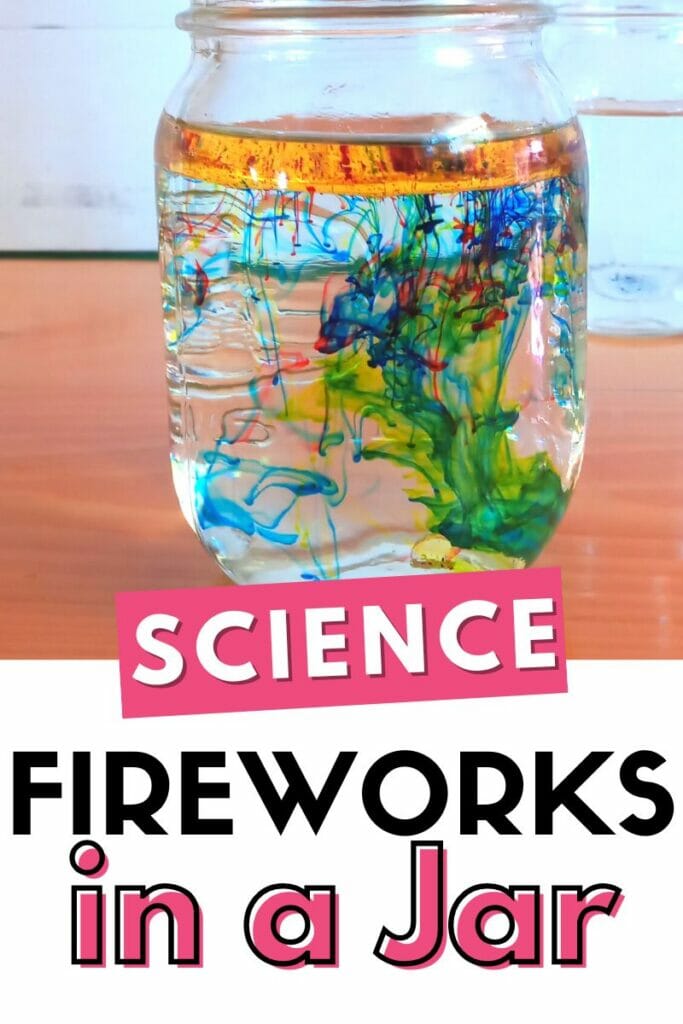Try out this easy food color science project that uses just a few simple kitchen supplies. This fun lesson can be created into your 4th of July or a New Year’s Eve lesson. Let’s get right to learning how to make fireworks in a jar for a simple science experiment.

This post contains affiliate links, see my disclosure policy for more information.
Fireworks in a Jar
I tested this one the other day to see if it was something that they should do individually or as a group. I think individually. Too much going on in one container to make them share or even try to see what is happening in one jar.
This isn’t a messy activity so having each child do their own isn’t a problem.
Our science activities and experiments are designed specifically for your family, teacher, or you! Easy to set up, and quick to conduct, most recreational science activities take 15 to 30 minutes to complete, and are ideal for helping you have some fun!
Plus, our product lists nearly always have nothing but free or inexpensive materials, so you can source them in your own home!
What You Need:
- a clear jar
- small bowl
- oil
- water
- food color
- fork
How to Make Fireworks in a Jar for Kids
Grab all your supplies, there isn’t any real down time, you just add and then add. Simple. Your kids can do this themselves from the time they are quite small.

Fill your jar about 3/4 the way full of water.
Put some oil in a small bowl. Add some food color to your bowl of oil. I used 4 colors, 3 drops of each.

The color drops don’t break up in the oil. Give it a little stir with a fork. The color won’t separate, you’ll instead see more “balls” or “beads” of color.

Pour your oil into the water.
You can see some individual colors starting to show.

The longer we watched, trying to get a few good pictures the more you could see happening. Just like fireworks.
Getting ready to clean up, I noticed the bubble at the bottom. It looks like some oil bubbled under the water with some food color drops.
What’s Happening with the Oil and Water
Liquid density is a fun experiment for kids to explore as it combines a bit of physics and also chemistry! As you observed above with your fireworks in a jar, oil and water do not mix.
But why don’t oil and water mix if they are both liquids?
Liquids can have different weights or densities because of their molecular structure. Water is heavier than oil so it sinks because it is made up of a different amount of molecules.
Food coloring (the easy-to-find kind from the grocery store is water-based) dissolves in water but not in oil. This is how the drops and oil remain separated in the container.

As you pour the container of oil and colored droplets into the jar of oil, the colored drops will begin to sink because they are heavier than the oil.
Once they reach the water in the jar, they start to dissolve in the water, and this makes the fireworks in a jar.
Does the temperature of the water affect what happens to the fireworks in a jar? The answer is YES! We tried this with both warm water and cold water. Spoiler: warm water happens faster. Try it for yourself though!

Fireworks in a Jar
Let’s learn how to make fireworks in a jar for a simple science experiment. This can be added to your 4th of July or New Year's Eve.
Materials
- a clear jar
- oil
- water
- food color
Tools
- fork
- small bowl
Instructions
- Fill your jar about 3/4 the way full of water.
- Put some oil in a small bowl. Add some food color to the bowl of oil. I used 4 colors, 3 drops of each.
- The color drops don't break up in the oil. Give it a little stir with a fork. The color won't separate, you'll instead see more "balls" or "beads" of color.
- Pour your oil into the water. Mine was quite dark at first when I added the oil and color. All the food colors will separate from the oil in the water.
- You can see some individual colors starting to show.
More Fun Science in a Jar
Homemade Lava Lamp for your Kids
